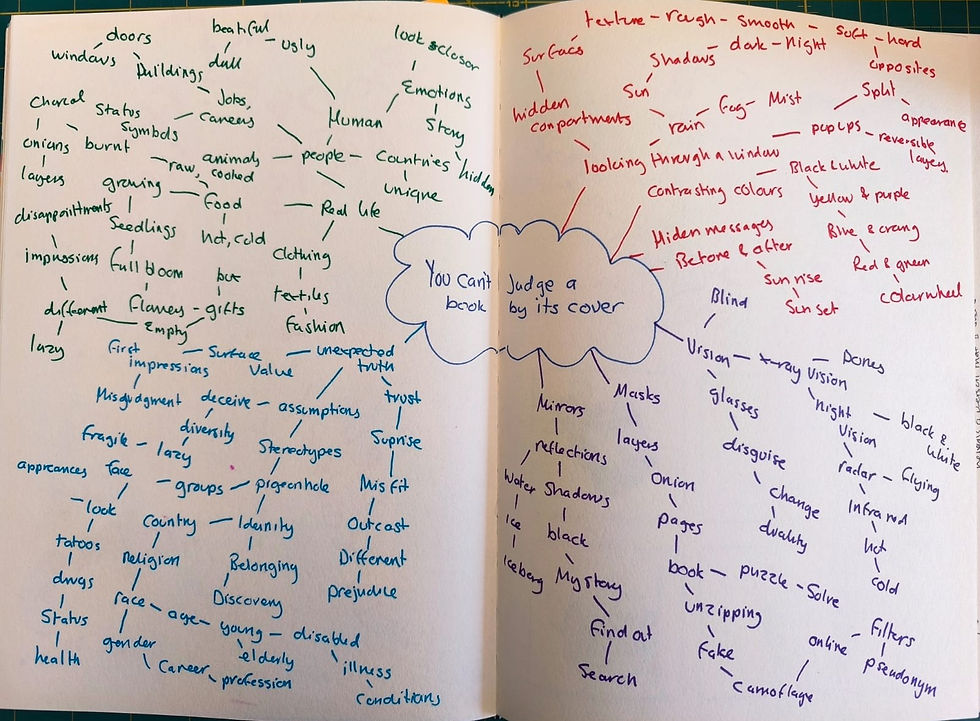Exercise 4: Generating ideas
- Christine Griever

- Sep 27
- 3 min read
Use one or more of the following book related sayings as a starting point to generate visual ideas and responses:
● Bookworms
● A closed/open book
● The oldest trick in the book
● You can’t judge a book by its cover
● In someone’s good/bad books
● By the book
During this early formative stage, aim to be as wide-ranging and imaginative as possible in your ideas. ALL ideas are valid at this point, so don’t censor; this is not the stage to decide what is a ‘good’ or ‘bad’ idea – at this point they are all just ‘ideas’ with equal merit. Let one idea flow fluidly, intuitively and organically into another to make unexpected links and associations. Record your thought processes and ideas using thumbnail sketches, spidergrams and annotations.
Thumbnail sketches are a way of recording ideas through quick pen or pencil line drawings. The quality of the drawing is not important; a drawing of a person does not need to be anatomically accurate, for example. The drawing serves as a visual reminder to you of a fleeting idea. Aim to make thumbnail drawings in the same quick way that you make short written annotations – keeping up with the flow of your ideas. Draw a range of visual and conceptual possibilities using the book sayings as your starting point. Aim to spend 45 minutes working on this, generating as much content, potential ideas, thumbnails, visual metaphors or imagined books as possible.
Thumbnails can give an indication of composition and art direction. For example, how does the subject sit in the frame? How is the subject lit? What particular attributes does that subject have? Thumbnail sketches, along with annotations, are a good starting point to begin exploring these aspects.
You can't judge a book by its cover
From a young age, we are taught not to judge a book by its cover. However, we often do! We also judge people by their appearance and make assumptions based on stereotypes. First impressions really do matter, both for individuals and for book covers.
When we see a book cover, we form expectations about its content based on the image. For example, when looking at a travel book, we think about seeing beautiful beaches, idyllic weather and exotic food, not an image of a gravestone. The cover needs to provide some idea about the book's contents. For the book to sell well, it must be eye-catching and effectively marketed to attract potential buyers.
I believe that the boundaries can be pushed when the design is conceptual and thought-provoking. Such covers can entice readers, making them more likely to read the blurb on the back of the book.
Moodboard
I decided to create a moodboard of different images from Pinterest and the internet. My research took me in many different directions, such as first impressions, stereotypes, appearances and assumptions. To see more, please click on the link https://app.milanote.com/1UrvL91GVYho8L?p=dPrFYAUJWOg

Brainstorming
From my research into the images for my moodboard, my brainstorming felt quite frenzied! I felt I had so many words stored in my mind that getting everything down on paper was quite a relief! I didn't realise that one quote would generate so many ideas and concepts. I felt the more I researched, the more interesting concepts came up.

Thumbnails
I spent about 50 minutes sketching thumbnails in my sketchbook and my ideas led me toward an approach centred around the sub-theme "not everything is what it seems." For example, I imagined an apple that, when sliced open, reveals an orange segment. I also explored visual metaphors, like a cat looking into a mirror, only to see a lion reflected back, highlighting that appearances can be very deceiving. I used an onion, which has multiple layers, to try to illustrate the point that as you peel each layer away, it reveals more depth and value. Through my thumbnails, I aimed to communicate the message that "you can't judge a book by its cover" using a variety of metaphorical ideas.


Reflection
This was a fascinating exercise. I chose the saying "You can't judge a book by its cover" because it resonated with me the most. Initially, I was focused on book covers and how this saying could be represented visually. However, as I started researching images for my moodboard, I realised it opened up a whole new category of ideas! I was not expecting that at all.
The concept developed into subcategories, such as stereotypes and assumptions about people based on their gender, class, religion and age. The list goes on. By brainstorming related words, I generated ideas about first impressions and even optical illusions. I found it fascinating that one sentence could lead to so many different ideas and concepts. Once I had sketched out my ideas visually with thumbnails, I could see my ideas coming to life and found that I was using a more metaphorical approach to developing my ideas.



Comments